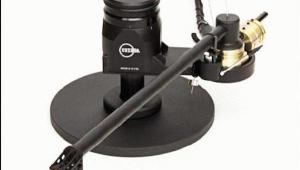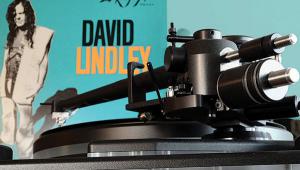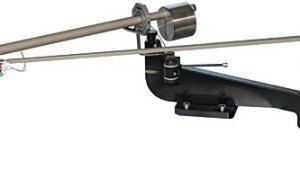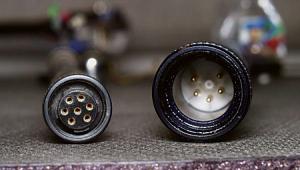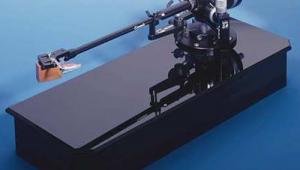Graham Engineering Phantom B-44 tonearm B44 Mk.II, October 2009
Bob Graham has been refining his tonearm since it first appeared in prototype form as the McIntosh Excalibur, back in the 1980s. As reported by Ken Kessler in his terrific book McIntosh "...for the love of music...," Graham, then at MIT and independently developing his tonearm, was introduced to McIntosh's Gordon Gow, who was in Massachusetts visiting area audio retailers. Gow was sufficiently impressed to fund further development and help Graham patent his design. However, a hitch in the accompanying McIntosh turntable's development and the advent of the Compact Disc meant that the project was canceled, leaving Graham to independently fund and market his Model 1 arm, which was first reviewed in Stereophile, by Dick Olsher, in March 1991.
Graham's original inverted-unipivot arm went through numerous upgrades and iterations before being replaced, in 2005, by the Phantom B-44. Though superficially similar to the old design, the B-44 represented a significant reimagining of the basic concept, with all new parts and a major innovation Graham called Magneglide: a magnet-based system that had the stability of a fixed-bearing arm while retaining the advantages of a unipivot (see my review for a detailed description of the arm).
In the new Phantom B-44 II ($4900), the material of the interchangeable armtube has been changed from ceramic to titanium. The taller, more massive headshell moves the cartridge-mounting surface down to the level of the center of the armtube. According to Graham, that provides for a greater range of adjustability of vertical tracking angle (VTA), compatibility with a wider variety of cartridges, and makes the Phantom more easy to "drop in" as a replacement for Graham 2.2 arms. More important, this change is said to provide a more efficient transfer of energy. An additional stainless-steel guide pin aids insertion of the wand in the pillar and better secures its rotational positioning. The wand attaches under tension to a nearly half-inch-wide post and connector of stainless steel, to produce what Graham claims is essentially a "connector-less connection."
The arm wand's internal wiring has been changed to a twisted pair of shielded, solid-silver wires with Teflon dielectric, finished with a silicone jacket that better damps the wand. The internal wiring of the wand connector to the DIN terminal block is a thinner Litz type because Graham found that the original, stiffer, Teflon-insulated wire tended to ever so slightly impede the arm's horizontal movement, which otherwise was essentially frictionless.
The improved Magneglide system uses smaller magnets placed closer together, which lowers the arm's mass and increases its stability. In addition, according to Graham, the new system provides better damping and produces a lot of "grabbing force without yanking." I'm all for eliminating yanking.
Graham has added a spirit level to the cylindrical bearing housing (patent pending). This makes adjustment of VTA accurate and repeatable, and is particularly useful in determining the starting point for such adjustments, when the armtube should be parallel to the surface of the LP. When the bubble sits between the two red lines, the arm is parallel to the record surface.
The precision tolerance of the B-44 II's VTA adjustment tower makes most other arms I've reviewed feel loose and sloppy—in fact, you needn't tighten the tower's grub screw, because it won't change the vertical alignment, nor will you hear a difference.
A heavier counterweight now better accommodates a wider variety of cartridges and, more important, can be placed closer to the pivot point to reduce the arm's moment of inertia. Graham has also slightly modified the pivot's bearing cup to help ensure that the bearing fits perfectly as soon as it's been inserted.
Installed in the Continuum Audio Labs Caliburn turntable's secondary arm-mount position, the original Phantom B-44 was my alternative reference tonearm to Continuum's own Cobra. The Graham's sonic performance was very good, but no match for the Cobra's speed and tonal neutrality; though still very good, the Phantom sounded somewhat slower and thicker. Various reports from readers comparing the Phantom to some other arms, such as the Breuer and Triplanar, claimed those designs were faster and more detailed. I found the Triplanar somewhat faster and airier as well, but the Phantom was still of reference quality, and the interchangeable arm wands, coupled with the Cobra's fussy setup needs, made the Graham design invaluable as a cartridge-reviewing tool.
It was easy enough to compare the Phantom B-44 with the Phantom B-44 II, and I easily heard major improvements in speed, air, high-frequency extension, and detail. Using the Lyra Titan i phono cartridge, the Phantom II sounded considerably faster and more open on top. Bass performance was unchanged, which was fine, as it was already well extended and extremely well controlled.
With its ease of setup, tracking agility, arm interchangeability, and ultra-high build quality, I consider the Phantom B-44 II to be among the most desirable arms currently available. While the Continuum Cobra sounds more linear, and is easily the most neutral-sounding arm I've heard (Image Hi-Fi's Dirk Sommers thinks the Cobra may be the Caliburn's "secret weapon"), the Phantom is now not far behind.—Michael Fremer
- Log in or register to post comments

